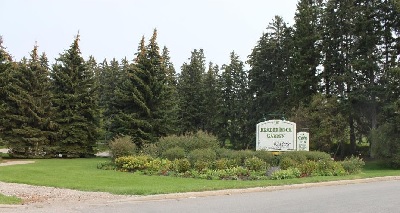Reader Rock Garden National Historic Site of Canada
Calgary, Alberta

Entrance to the garden
© Parks Canada | Parcs Canada
Address :
325 25th Avenue Southeast, Calgary, Alberta
Recognition Statute:
Historic Sites and Monuments Act (R.S.C., 1985, c. H-4)
Designation Date:
2018-02-27
Dates:
-
1890 to 1890
(Significant)
-
1913 to 1913
(Significant)
-
1943 to 1943
(Significant)
-
1908 to 1908
(Significant)
-
1923 to 1923
(Significant)
Other Name(s):
-
Reader Rock Garden
(Designation Name)
Research Report Number:
2016-016, 2015-019
Plaque(s)
Existing plaque: 325 25th Avenue Southeast, Calgary, Alberta
William R. Reader, Calgary’s influential Parks Superintendent from 1913 to 1942, laid out this Arts and Crafts-style alpine rockery, which he maintained for decades. Built into a steep hillside near the Union, Chinese, and Burnsland Cemeteries, its rock paths, steps, and walls formed numerous planting beds. They tested and showcased the possibilities of gardening in Calgary, challenging assumptions that the southern Alberta climate was too hostile for agriculture and horticulture. Admired for its beauty and botanical diversity, this garden has long been a source of inspiration for professional and amateur gardeners.
Description of Historic Place
The Reader Rock Garden National Historic Site of Canada is located within Union Cemetery in the City of Calgary. It is an Arts and Crafts style alpine rockery, a garden type popular in Europe and North America at the beginning of the 20th century. The garden consists of a matrix of rock paths, steps, walls and water features forming planting beds divided into sections containing thousands of native and non-native plant and tree specimens. A curved driveway leads up to the Superintendent’s Cottage. An arched metal gate leads into the garden’s five distinct areas. Official recognition refers to Reader Rock Garden which covers 0.57 hectares and is located within Union Cemetery in the City of Calgary. It excludes the Superintendent’s Cottage reconstructed in 2005 on the site of the original.
Heritage Value
Reader Rock Garden was designated a National Historic Site of Canada in 2018. It is recognized because:
• established in 1913 and developed until 1942, this horticultural garden is a showcase for the horticultural, ecological, and aesthetic possibilities of gardening in the harsh climate of Calgary, and the need to illustrate the potential of gardening in Western Canada;
• in its heyday, it was regarded as one of the most beautiful and successful gardens in Western Canada, combining the informal aesthetics of the Edwardian Arts and Crafts movement with the structure and content of the highly popular alpine rock garden typology;
• its founder, William Roland Reader was one of a small number of municipal parks superintendents in Canada who significantly shaped the open space systems of their cities through professional skill and knowledge, personal energy, dedication and long-service. This garden supported horticultural work in the larger urban parks system, including the adjacent cemeteries developed by Reader
The century-old garden can be appreciated for the beauty of its plantings and ingenuity of design. Its importance to Canadian history is as an example of the promotion of horticultural possibilities of the Canadian Prairies when European settlement in Western Canada was in its infancy. The garden was laid out between 1913 and 1943 by William Roland Reader, Calgary’s most influential parks superintendent. Reader created one of the few significant gardens in Western Canada in an environment believed to be hostile to agriculture. Undaunted by desert-like conditions, chinook winds, and extremes temperatures, his personal garden became a vehicle for promoting settlement and a successful experiment in civic beautification. The creation of the garden was driven by two factors: the encouragement of European settlement at a time when southern Alberta’s climate was considered hostile to agricultural and horticultural development, and the City Beautiful movement, which linked civic beauty with social progress. Reader drew from British gardening influences popular in the late 19th and early 20th centuries, and adapted them to the Canadian prairies. The resulting garden was well appreciated in its day for its beauty and design, and inspired private citizens to follow Reader’s example in their own gardens.
Source: Historic Sites and Monuments Board of Canada, Minutes, November 2016.
Character-Defining Elements
Key elements contributing to the heritage value of this site include: its location within Union Cemetery in the City of Calgary; its topography; the surviving evidence of William Roland Reader’s naturalistic design and layout including the South Slope, Upper Garden, High Rockery, and Western Slope, the West Garden and the area, including the lawn and perennial beds, surrounding the reconstructed superintendent’s house; its vegetation representing Reader’s documented plantings and collections; the remnant evidence of natural and created ponds, streams, and pathways; the views opening as the path ascends and descends the hill; the rock retaining walls, stairs, and paths; its entrance arch; its views of the city from the points in the garden.